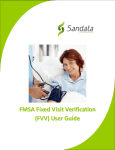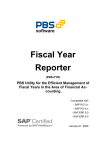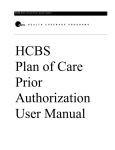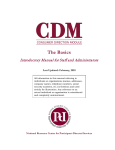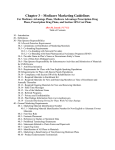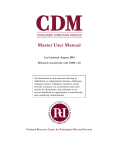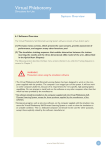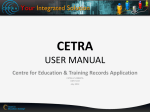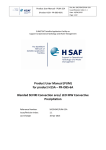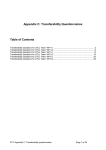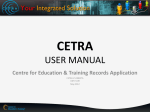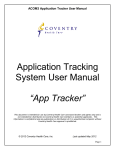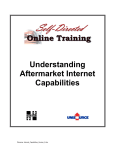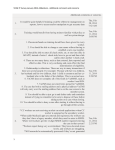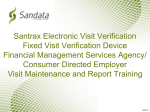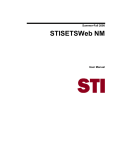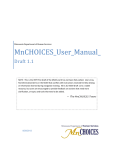Download Appendix II: The Consumer Direction Module Table of Contents
Transcript
Appendix II: The Consumer Direction Module
Table of Contents
The Consumer Direction Module: Overview������������������������������������������������������������������� II-2
Development and Current Use of the CDM����������������������������������������������������������������� II-3
Who Can Use the CDM?��������������������������������������������������������������������������������������������������� II-4
Participants��������������������������������������������������������������������������������������������������������������������� II-4
Participants’ Representatives��������������������������������������������������������������������������������������� II-5
Legal Guardians������������������������������������������������������������������������������������������������������������� II-5
Support Broker Agent & Agency ��������������������������������������������������������������������������������� II-5
State and Local Program Staff������������������������������������������������������������������������������������� II-6
Financial Management Service Agent & Agency������������������������������������������������������� II-6
State Administrators����������������������������������������������������������������������������������������������������� II-7
System Administrators������������������������������������������������������������������������������������������������� II-7
Guest Users������������������������������������������������������������������������������������������������������������������� II-8
Primary Features of the CDM ������������������������������������������������������������������������������������������� II-8
Participant File��������������������������������������������������������������������������������������������������������������� II-8
Participant Spending Plan/Monthly Expenditure Statement������������������������������������� II-9
Reports��������������������������������������������������������������������������������������������������������������������������� II-9
Ability to Tailor the CDM to Each State’s Program ��������������������������������������������������� II-11
Costs and Resources to Implement the CDM ������������������������������������������������������������� II-12
Costs����������������������������������������������������������������������������������������������������������������������������� II-13
User Manuals & Training��������������������������������������������������������������������������������������������� II-13
Enhancements������������������������������������������������������������������������������������������������������������� II-14
State Support Provided by the Center����������������������������������������������������������������������� II-14
Endnotes��������������������������������������������������������������������������������������������������������������������������� II-15
DEVELOPING AND IMPLEMENTING SELF-DIRECTION PROGRAMS AND POLICIES: A HANDBOOK | May 4, 2010
II-1
Appendix II
The Consumer Direction Module1
Information technology designed specifically for self-direction programs can
empower participants by giving them a timely, efficient, user-friendly tool for
completing required paperwork and for interacting with their counselors (also
called support brokers, support coordinators, and other names) and financial
management services (FMS) providers to manage their individual budgets. This
same information technology can also be configured to serve as a management
information system to assist state program administrators in monitoring
participants’ use of their budgets and evaluating the program’s performance on a
wide range of indictors.
Information technology is already widely used to administer Medicaid programs.
For more than 25 years, the federal government has required states to have
computerized Medicaid Management Information Systems (MMIS) to process
provider claims and to generate a variety of reports on service utilization and
expenditures; states must also comply with federal data reporting requirements.
With respect to Medicaid-funded home and community-based services (HCBS),
many states also employ standardized assessment tools to make coverage
determinations and store the assessment data in computerized information
systems, which can be linked to the MMIS. This enables program administrators
to measure, for example, the service utilization/expenditure patterns of Medicaid
program participants by disability profile, and also to monitor whether and to
what extent they receive the services authorized on the basis of their individual
needs assessment.
These existing information technologies are intended solely for the use of
Medicaid program administrators and their contractors and/or providers of
traditional Medicaid services. The design of information technology for selfdirected services poses a whole new set of challenges because, in addition to these
users, some of the functions of the technology must also be available to program
participants and/or their representatives (hereafter, participants).
This Appendix describes an information technology developed for and designed
specifically to meet certain unique requirements of self-direction programs.
This technology—called the Consumer Direction Module (CDM)—is a secure
web-based software application specifically designed to support self-direction
programs that provide individual budgets. The CDM can also be linked to states’
MMIS and assessment databases, if a state elects to do so.2
For participants, the CDM makes it possible to monitor the financial status of
their accounts by accessing monthly accounting statements, to develop and revise
DEVELOPING AND IMPLEMENTING SELF-DIRECTION PROGRAMS AND POLICIES: A HANDBOOK | May 4, 2010
II-2
their spending plans electronically, and to share their proposed plans quickly and
efficiently with their counselors (if the state has delegated authority to them to
approve routine expenditures) and with state program officials (who must review
and pre-authorize proposed spending on non-routine goods and services).
The use of Excel spreadsheets allows the electronic template to be programmed
to automatically add in payroll taxes and other required costs associated
with workers’ wages (e.g., overtime payments when applicable). Similarly,
the template makes it easier to ensure that proposed spending does not
exceed participants’ allowance or available funds. Moreover, forms filled out
electronically—unlike traditional paperwork—are always legible, and therefore
avoid some of the delays that can occur when traditional paperwork cannot be
processed because it is illegible.
For providers of support services—counselors and FMS entities—the CDM
similarly streamlines and speeds up communication both with participants and
with each other. The CDM also facilitates record-keeping and can be programmed
to generate routine reports and reminders, for example, that a regularly scheduled
visit or phone call is due.
Finally, the CDM enables state program administrators to monitor individual
participants’ enrollment status and their individual accounts as well as to track
aggregate statistics such as the number of enrolled and disenrolled participants
and reasons for disenrollment; aggregate expenditures by participants; and types
of goods and services approved for purchase. Program administrators can also
determine, both for individuals and in the aggregate, the time lag from enrollment
to development and approval of a spending plan and the start-up of self-directed
services. They can also monitor the extent of under-spending and/or savings
being accumulated on an individual and aggregate basis. Having such information
immediately accessible is invaluable for quality management and continuous
quality improvement strategies.
The Consumer Direction Module: Overview
The purpose of the CDM is to:
■■
Facilitate and simplify communication among participants and program staff
■■
Facilitate the timely processing of program information
■■
Provide data in reports that permit timely and efficient monitoring
■■
Improve quality by creating program efficiencies and providing timely
information to program participants and administrators.
The CDM software, initial training, and materials on installation and use are
available at no cost through the National Resource Center for Participant-Directed
DEVELOPING AND IMPLEMENTING SELF-DIRECTION PROGRAMS AND POLICIES: A HANDBOOK
Appendix II: The Consumer Direction Module | May 4, 2010
II-3
Services (hereafter, the Center). There is a cost for vendor support during
installation and states are responsible for installing and supporting the software as
they would any other business system.
The Center is available to assist states that want to implement the CDM to prepare
for implementation by reviewing user roles, adapting the CDM to fit a state’s
program, and providing training and one-time data uploads. States do not have to
have received a C&C grant to receive assistance from the Center.
CDM Technical Features
■ The CDM is a web-based application { { ■ ■ ■ ■ The software is installed on one computer, a PC server, which is accessed through the Internet using commonly available web browsers. Some customization for each state is possible.
The CDM is a local system, with no interfaces allowing communication between the CDM and other computer systems supplied. Each state determines what interfaces it wants and is able to develop.
The CDM requires some data transfer with the financial management services (FMS) agency (or FMS provider) to provide spending plan information and to gather information about participants’ expenditures.
The CDM meets all applicable HIPAA regulations.
The CDM does not process receipt and disbursement of funds to and from each state’s Medicaid financial system.
Development and Current Use of the CDM
States that received Cash & Counseling (C&C) grants were offered the
opportunity to help develop and/or adopt the CDM. Some chose not to do so
because they were concerned that the CDM might overlap and prove incompatible
with or inferior to their states’ own current or planned information systems.
Alabama, Rhode Island, and West Virginia each provided a program and
information technology representative to serve on the CDM steering committee
during the development phase, and New Mexico joined the steering committee
during the testing phase. Participation on the steering committee enabled these
states to have input into the development of the CDM and to help ensure that it
met their needs.
DEVELOPING AND IMPLEMENTING SELF-DIRECTION PROGRAMS AND POLICIES: A HANDBOOK
Appendix II: The Consumer Direction Module | May 4, 2010
II-4
Currently, Rhode Island and West Virginia are using the CDM. Alabama installed
the CDM in a test region and is preparing for implementation in this region. New
Mexico installed the CDM in spring 2007 in a test region and is preparing for
statewide implementation in 2008.
Who Can Use the CDM?
The following individuals with a role in a self-direction program can use the CDM:
■
Participant
■
FMS Agent & Agency
■
Participant Representative
■
State Administrator
■
Legal Guardian
■
System Administrator
■
Support Broker Agent & Agency
■
Guest User
■
State and Local Program Office
States can customize the terms used to describe various roles in the program. For
example, states may use the term “resource consultant” or “counselor” rather
than “support broker.” Once the term is changed in the CDM, the change will be
reflected throughout the CDM. States need to be aware of the default user names
since they will be referred to in the system and state administrator pages as well
as the user manuals. Editing the user manuals is discussed later in this Appendix.
The ways in which these individuals can use the CDM are described next.
Participants
The CDM serves as participants’ Internet link to people and agencies that help
them direct their personal care services. Participants can use the CDM to develop
their spending plan and can access their file at any time to view monthly budget
statements, edit their file, and enter comments.
Participants are encouraged to use the CDM because it will make it easier
for them to obtain forms (e.g., employment forms) and information about the
program, manage their budgets, and communicate with those who help them to
direct their services. The budget management features include the ability to
■■
Complete a spending plan form
■■
Submit a spending plan for approval
■■
View monthly reports of income and payments made from the account
■■
Check account balance and savings
DEVELOPING AND IMPLEMENTING SELF-DIRECTION PROGRAMS AND POLICIES: A HANDBOOK
Appendix II: The Consumer Direction Module | May 4, 2010
II-5
Participants’ Representatives
Participants may select someone to help them make decisions and manage
employees. Once participants designate a representative, that individual’s role
will be reflected in the participants’ file, including whether the participants have
authorized the representative to use the CDM on their behalf (e.g., authorization
to read, change, or add to pages in the CDM).
Legal Guardians
Participants’ legal guardians can use the system in place of the participant,
and their authority will be reflected in the participant’s CDM file. The support
broker will identify the authority of the legal guardian, as specified by the state.
Participants with legal guardians are able to read everything in their file, but may
not change the information.
Support Broker Agent & Agency
Support brokers can use the CDM to manage their caseloads. The CDM
provides immediate access to the files of participants in their caseloads and
to other program forms and reports. Additionally, it automates many program
communications.
Support brokers can use the CDM to:
■■
Get information from and submit information to participants’ files
■■
Update participants’ information
■■
Download blank expenditure/spending plan (Excel worksheet) and other
forms
■■
Upload completed participant-directed budgets
■■
Make changes to participant-directed budgets at the participants’ direction
■■
Enter observations made during contacts with participants
■■
Check participants’ account balances at their request
■■
Receive alerts and notifications about changes in participants’ files
■■
Generate reports
■■
Send broadcast messages to other CDM users
In addition to the support broker functions listed above, support broker agency
users will also have the administrative authority to add support brokers to the
CDM.
DEVELOPING AND IMPLEMENTING SELF-DIRECTION PROGRAMS AND POLICIES: A HANDBOOK
Appendix II: The Consumer Direction Module | May 4, 2010
II-6
State and Local Program Staff
State and local program staff (1) ensure that the program’s policies and
procedures are reflected in the CDM; (2) work with the state system
administrator to configure the CDM to their state’s program; and (3) use
the CDM on a daily basis for management and administrative tasks such as
approving participants’ spending plans and monitoring the program. The CDM
greatly facilitates program management and administration by providing both
real time access to information and aggregated reports.
State and local program staff can use the CDM to:
■■
Create an entry for a new participant
■■
Assign a support broker or FMS agency
■■
Approve participant-directed budgets (responsibility may vary by state)
■■
Monitor participant-directed budgets, changes in the budgets, and
participants’ spending
■■
Review support broker case records
■■
Review reports from FMS agents
■■
Edit participants’, support brokers’, and FMS agencies information included
in the CDM
■■
Send messages to other user groups
■■
Close a case
■■
Generate reports
Financial Management Service Agent & Agency
FMS agents are an essential program support for participants. They allow
participants who are employers-of-record but who have limited employer
knowledge and skills to control their budget and manage their employees. By
handling the payroll, check writing, and taxpaying associated with participants’
approved spending plans, the FMS agent ensures that the program spends
Medicaid funds lawfully and that all spending is accurately documented.
FMS agents can use the CDM to:
■■
Enter employee information in participants’ files
■■
Receive participants’ spending plans and changes made to the plan
■■
Receive changes in participants’, support brokers’, and workers’ information
DEVELOPING AND IMPLEMENTING SELF-DIRECTION PROGRAMS AND POLICIES: A HANDBOOK
Appendix II: The Consumer Direction Module | May 4, 2010
■■
Send the monthly report of income and payments made for participants
■■
Generate other reports
II-7
In the CDM, a person working in an administrative capacity in a financial
management services agency is called by the role name “FMSA Admin” or
“FMSA.” In addition to all of the FMS agent functions listed above, FMSA users
will also have the administrative authority to:
■■
Create FMS agent users in the CDM
■■
Determine and input the tax rate for spending plans
State Administrators
State administrators have the same authority as state and local program staff. In
addition, they are allowed to configure the CDM for their specific program use
and can perform the same administrative functions as system administrator users
(see below). State and system administrators are encouraged to work together to
configure the CDM for their state program’s use.
In addition to having access to state and local program user functions, state
administrators can use the CDM to:
■
Add or change users
■
Determine values for dropdown lists
■
Upload the program logo
■
Maintain item and service codes
■
Configure spending plan categories
■
Add or change affirmations
■
Establish permissions by role
■
Create special fields
■
Establish state-specific role names
■
Set required fields
■
Set homepages for users
■
Add a financial management service
agency
■
■
Add a support broker agency
Set role communications including
alerts, notifications, reports, and notes
System Administrators
System administrators are responsible for the initial setup and ongoing
maintenance of the CDM. The CDM is a very flexible system that allows system
administrators to configure it to accommodate specific state program decisions.
This configuration determines whether icons, tabs, and fields appear on the CDM
screens viewed by all other users, and what users are able to do. The configuration
can also be changed after program implementation.
See the state administrator functions above for examples of functions for system
DEVELOPING AND IMPLEMENTING SELF-DIRECTION PROGRAMS AND POLICIES: A HANDBOOK
Appendix II: The Consumer Direction Module | May 4, 2010
II-8
administrators. With the exception of state and local program user functions, state
administrators and system administrator have the same privileges.
Guest Users
The CDM has four guest user roles that can each be configured for use by
different groups, for example, contracted assessment personnel or program
evaluators. Each guest user role can be configured differently (e.g., to permit
access only to specified reports). More than one person may be assigned to each
guest user role.
Primary Features of the CDM
The CDM has five unique features: the participant file, the spending plan,
the monthly expenditure statement, reports, and state configurability. Each is
described below.
Participant File
Participant files have 10 main sections/pages:
■■
■■
■■
■■
■■
■■
■■
■■
Personal: Lists personal and contact information.
Program: Contains administrative details about program participation, for
example, the date of enrollment and the date of last assessment.
Financial: Contains the budget, spending plan, and monthly statements.
FMSA: Displays the name and contact information for the financial
management services agency that will assist with employer-related
bookkeeping tasks.
Support Broker: Displays the name of participants’ support brokers and
contact information for them. If the support broker works for an agency, the
agency information will also be shown in this section.
Medical Provider: Displays a page of information about the participant’s
primary care physician and other medical providers.
Participant Representative: If a participant has a representative, the
representative’s contact information will be displayed on this page.
Legal Guardian: If a participant has a legal guardian, this page will list the
contact information.
■■
Employee: Contains a list of the participant’s employees.
■■
Notes: Includes all notes written in a participant’s file by all CDM users.
DEVELOPING AND IMPLEMENTING SELF-DIRECTION PROGRAMS AND POLICIES: A HANDBOOK
Appendix II: The Consumer Direction Module | May 4, 2010
II-9
The participant file is described in further detail in the user manual. CDM user
permissions can be configured to view, edit, and add information to the participant
file as needed.
Participant Spending Plan/Monthly Expenditure Statement
Once their budgets have been approved, participants are able to create a spending
plan in the CDM using an Excel spreadsheet. (See sample form below.) When the
plan is ready to be reviewed, the Excel spreadsheet is uploaded into the CDM for
other users to view as needed.
FMSAs use the same form (with different formulas) to give participants a monthly
statement showing how their budget was spent. The statement is downloaded from
the CDM by FMS agents to populate with expenditure data. Once completed, the
FMS agents are able to upload the monthly statement into the CDM and it will
populate the participant’s file so other users can view the information.
Reports
The CDM is programmed to provide numerous reports to help states monitor their
self-direction programs. The system allows users to easily generate other reports
based on information stored in the CDM.
The CDM includes a set of default reports and allows users to create ad hoc
reports as needed. The default reports are
1. Demographic Characteristics of Participants
2. Amount of Monthly Budget
3. Spending as of End of Month
––Participants by Percent of Authorized Budget Spent at End of Month
––Participants with More than 100% of Budget Spent by End of Month, by
Support Broker
––Participants with Less than 95% of Budget Spent by End of Month, by
Support Broker
4. Savings Plan Report
––Participants by Dollar Amount of Goal of Savings Plan for Specified
Purpose
––Participants by Percent of Authorized Budget in Savings Plan for Specified
Purpose
––Participants by Dollar Amount Saved in Savings Plan for Specified Purpose
DEVELOPING AND IMPLEMENTING SELF-DIRECTION PROGRAMS AND POLICIES: A HANDBOOK
Appendix II: The Consumer Direction Module | May 4, 2010
State or Local Program Information
935
First and Last Name
Address
City, State & Zip Code
First and Last Name
Representative Name:
Service Type/Description
Employee
Goal #
Service Type/Description
Goal
Description of Item/Good
Description of Item/Good
Worker`s Hours per
Comp
week
$0.00
$0.00
$0.00
$0.00
$0.00
$0.00
$0.00
$0.00
$0.00
$0.00
Monthly Statment for:
mm/yyyy
Monthly Budget Amount:
$3,000.00
Medicaid Number
xxxxx
Effective Date:
mm/dd/yyyy
Total Taxes
Hourly Wage per Hour
$0.00
$0.00
$0.00
$0.00
$0.00
$0.00
$0.00
$0.00
$0.00
$0.00
Sum of Hourly
Wages &
# of Hours
Taxes
per Month
$0.00
$0.00
$0.00
$0.00
$0.00
$0.00
$0.00
$0.00
$0.00
$0.00
Employee Tax
Rate
Goal #
Provider Name
Frequency
Vendor Purchased From
Vendor
One Time Purchased
From
Purchase
Proposed
Date of
Purchase
Estimated
Cost
Total
Monthly
Cost
Service Code
$0.00
$0.00
$0.00
$0.00
$0.00
$0.00
$0.00
$0.00
$0.00
$0.00
Total :
$0.00
Total
Monthly
Cost
$0.00
$0.00
$0.00
Total :
$0.00
Employee
Unused Funds to be saved
#
for:
Paid (Y/N) Additional Cost per Month
Back-up Provider
–
ACME Services LLC
4400 N. Broad St. Philadelphia, PA 19104
(111)222-4444
29159
2152
Participant Name:
Participant Address:
II-10
Unit Cost
# Of Units
per Month
Unit Cost
# Of Units
per Month
Item Code
Est. Months
needed to
Save
Purchase
Amount
Item Code
Service Code
Total
Monthly
Cost
$0.00
$0.00
$0.00
$0.00
Total :
$0.00
Total
Monthly
Cost
$0.00
$0.00
$0.00
$0.00
Total :
$0.00
Monthly
Savings
Total :
$0.00
Total :
$0.00
Total :
$0.00
DEVELOPING AND IMPLEMENTING SELF-DIRECTION PROGRAMS AND POLICIES: A HANDBOOK
Appendix II: The Consumer Direction Module | May 4, 2010
II-11
––Participants by Savings Accumulated as a Percent of Savings Goal
––Participants with More than 100% of Savings Goal Accumulated But No
Purchase Made, By Support Broker
5. Assessment Report
––Participants by Time to Next Regularly Scheduled Assessment
––Participants with Regularly Scheduled Assessments Past Due by 30 Days
or More, by Support Broker
6. In-Person Monitoring Report
––Participants by Time to Next Regularly Scheduled In-Person Monitoring
7. Incident Tracking Report
8. Grievance Tracking Report
9. Appeals Tracking Report
10.Report on Time from Enrollment to Receipt of First Services under a Budget
––Number and Percent of Participants by Time to Receipt of First Services
under a Budget
––Percent of Enrollees Who Had Not Received Services under a Budget 90
Days after Enrollment for the Each of the Last Twelve Months, by Month
11.Enrollment and Disenrollment Report
––Cumulative through the End of Month X
––Detail on Reasons for Disenrollment
––Enrollment in Each of the Last Twelve Months, by Month
12.Enrollment in the program, by Referral Program
13.Recipients of Services Under an Individual Budget and Dropouts, by
Referral Program
Ability to Tailor the CDM to Each State’s Program
The CDM was designed to allow states to configure the software to their specific
program features. Some of the items that can be configured are:
■■
Application settings
––User and password configuration
––State customization
DEVELOPING AND IMPLEMENTING SELF-DIRECTION PROGRAMS AND POLICIES: A HANDBOOK
Appendix II: The Consumer Direction Module | May 4, 2010
■■
II-12
Field configuration
––Special fields
––Required fields
■■
Financial
––Spending plan categories
––Spending plan columns
■■
Affirmations (under Application settings)
■■
Drop down lists
■■
Roles and permissions
––Role names
––Role permissions
■■
Alerts and notifications
––Alerts (without editing recipient lists)
––Notifications (without editing recipient lists)
■■
Upload forms and reports
■■
Edit role communications
■■
Define Local Program Offices
■■
Set FMS Agencies
■■
Set Support Broker Agencies
■■
Add users
The system administrator manual thoroughly describes all of the items that can
be configured and the user manual index identifies the default settings in the
CDM system for each configurable item. The CDM is delivered to states with the
default configurations as a starting point.
Costs and Resources to Implement the CDM
When determining whether to use the CDM, states need to consider its cost—
both initial and ongoing—as well as available training and materials, future
enhancements, and technical assistance from the National Resource Center for
Participant-Directed Services. Each of these items is discussed below.
DEVELOPING AND IMPLEMENTING SELF-DIRECTION PROGRAMS AND POLICIES: A HANDBOOK
Appendix II: The Consumer Direction Module | May 4, 2010
II-13
Costs
The current vendor cost for assisting states to install the CDM, including 40 hours
of technical phone support, is $5000. The source code, installation manual, and
user manuals are supplied at no cost in return for providing aggregate data to the
Center.
In addition, an optional one-time upload of existing program data currently costs
$5,000. The one-time upload option allows states with existing program data to
load it into the CDM rather than manually entering it.
Costs for creating an interface between the CDM and other state software systems
are borne by the state. Based on input from the CDM steering committee, staffing
requirements to maintain and support the system are estimated in the table below.
Estimated Resources to Maintain the CDM and Support Users
Management Resources
Hours per Month
State Managerial Oversight
2
State CDM Administrator (can be a non-technical person)
12
Help Desk
12
IT Resources
Network Administrator
4
Database Administrator*
1
Developer/Report Writer*
3
Total
32
* One person can fill both positions.
User Manuals & Training
User manuals for each role in the CDM (excluding guest roles) are provided.
These manuals are also available in Word format to allow states to edit them to
reflect their customization of the CDM. For example, if a state changes the term
“support broker” to “counselor”, this change can be made in the support broker
manual. The manuals include both text explanations and illustrations of the CDM.
DEVELOPING AND IMPLEMENTING SELF-DIRECTION PROGRAMS AND POLICIES: A HANDBOOK
Appendix II: The Consumer Direction Module | May 4, 2010
II-14
Enhancements
Since the start of the CDM project, a number of enhancement requests and
ideas have been generated by the CDM steering committee and users. Small
enhancements have been made to the CDM and the Center maintains a list of
proposed enhancements for future consideration.
An enhancement project was completed in early 2008. which will allow FMS
agencies to obtain and distribute all participant spending plan and monthly
statement data from the CDM at one time, rather than having to access this
information through each individual participant’s file. This FMSA Data Connector
Project includes functionality that will decrease the amount of time FMSA users
will need to retrieve spending plan information as well as reduce the data entry
time for providing monthly statement information.
The steering committee continues to meet to provide oversight on CDM
enhancements and requests for enhancements and to provide support for states
both using and preparing to use the CDM. States interested in the CDM are
encouraged to join the steering committee to obtain more information on the
CDM and for support in the implementation process.
DEVELOPING AND IMPLEMENTING SELF-DIRECTION PROGRAMS AND POLICIES: A HANDBOOK
Appendix II: The Consumer Direction Module | May 4, 2010
II-15
Endnotes
1 Angela Sutkaitis is the lead author of this Appendix. Pamela Doty is a
contributing author.
2 The US Department of Health & Human Services, Office of the Assistant
Secretary for Planning and Evaluation funded the development of the
Consumer Direction Module. The Robert Wood Johnson Foundation and the
Administration on Aging provided some additional funding.
DEVELOPING AND IMPLEMENTING SELF-DIRECTION PROGRAMS AND POLICIES: A HANDBOOK
Appendix II: The Consumer Direction Module | May 4, 2010
















